Komodo Dragon
Varanus komodoensis
Only found on five Indonesian islands!
Advertisement
Komodo Dragon Scientific Classification
- Kingdom
- Animalia
- Phylum
- Chordata
- Class
- Reptilia
- Order
- Squamata
- Family
- Varanidae
- Genus
- Varanus
- Scientific Name
- Varanus komodoensis
Read our Complete Guide to Classification of Animals.
Komodo Dragon Conservation Status
Komodo Dragon Facts
- Prey
- Pigs, Deer, Water Buffalo
- Name Of Young
- Pup
- Group Behavior
- Solitary
- Fun Fact
- Only found on five Indonesian islands!
- Estimated Population Size
- 3,000 - 5,000
- Biggest Threat
- Hunting and habitat loss
- Most Distinctive Feature
- Long and deep forked tongue to taste the air
- Other Name(s)
- Komodo Monitor
- Incubation Period
- 8 -9 months
- Age Of Independence
- On hatching
- Habitat
- Open woodland and hillsides
- Diet
- Carnivore
- Average Litter Size
- 20
- Lifestyle
- Diurnal
- Common Name
- Komodo Dragon
- Number Of Species
- 1
- Location
- Komodo National Park
- Slogan
- Only found on five Indonesian islands
- Group
- Reptile
View all of the Komodo Dragon images!
Key Facts
- Komodo dragons are apex predators in their environment.
- They prefer to ambush their prey and attack with great speed and ferocity.
- Their young are independent of the time they hatch and take to tree branches for safety.
Classification
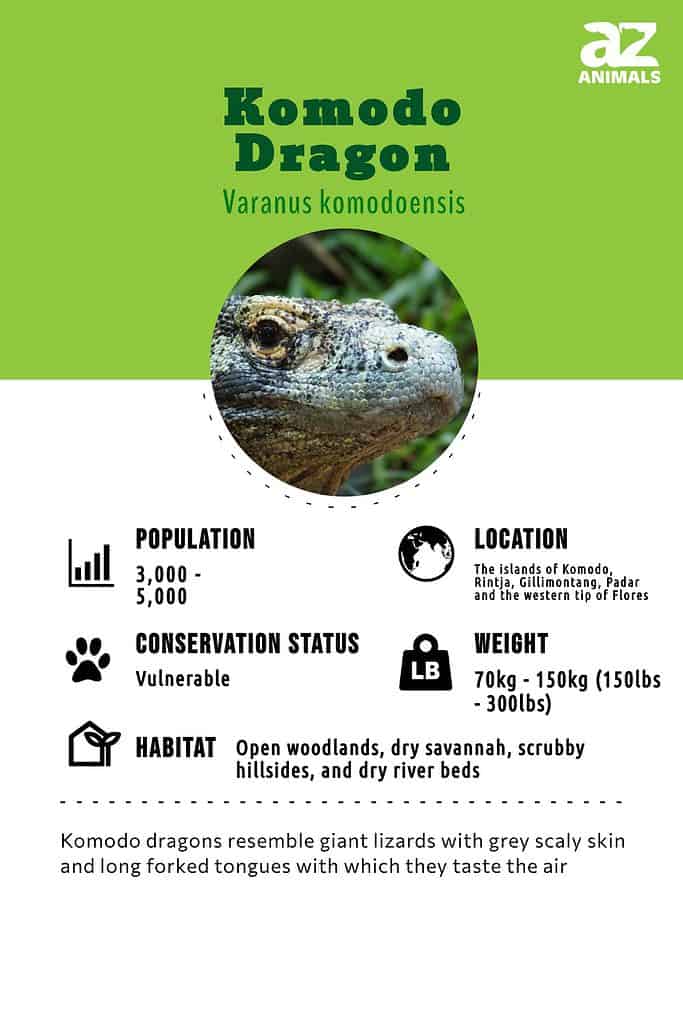
The Komodo Dragon is a large species of lizard that is only found on a handful of islands in the Indonesian archipelago. Not known to the world until the First World War, the Komodo Dragon is actually a species of Monitor Lizard that evolved in isolation for millions of years. These lizards are not only the largest in the world but are also one of the most aggressive and dangerous. They are so powerful that they are able to take down prey many times their own size. Komodo Dragons are in severe danger of extinction in their natural environments due to climate change, habitat loss, and a shortage of prey. Population decline has led to these lizards being listed on the IUCN’s Red List, providing this species with legal protection.
Evolution
The komodo’s very own evolutionary branch made the move to Asia from Australia as a result of the collision of the two continents 15 million years ago.
The presence of the komodo dragon on the southernmost continent is further supported by evidence that it also mated with the sand monitor’s forbears.
However, its true origins began 40 million years ago when its ancestors made their way from Asia to Australia, where its ancestors grew to immense sizes, with the Varanus priscus being the largest of all at 23 feet long.
Anatomy and Appearance
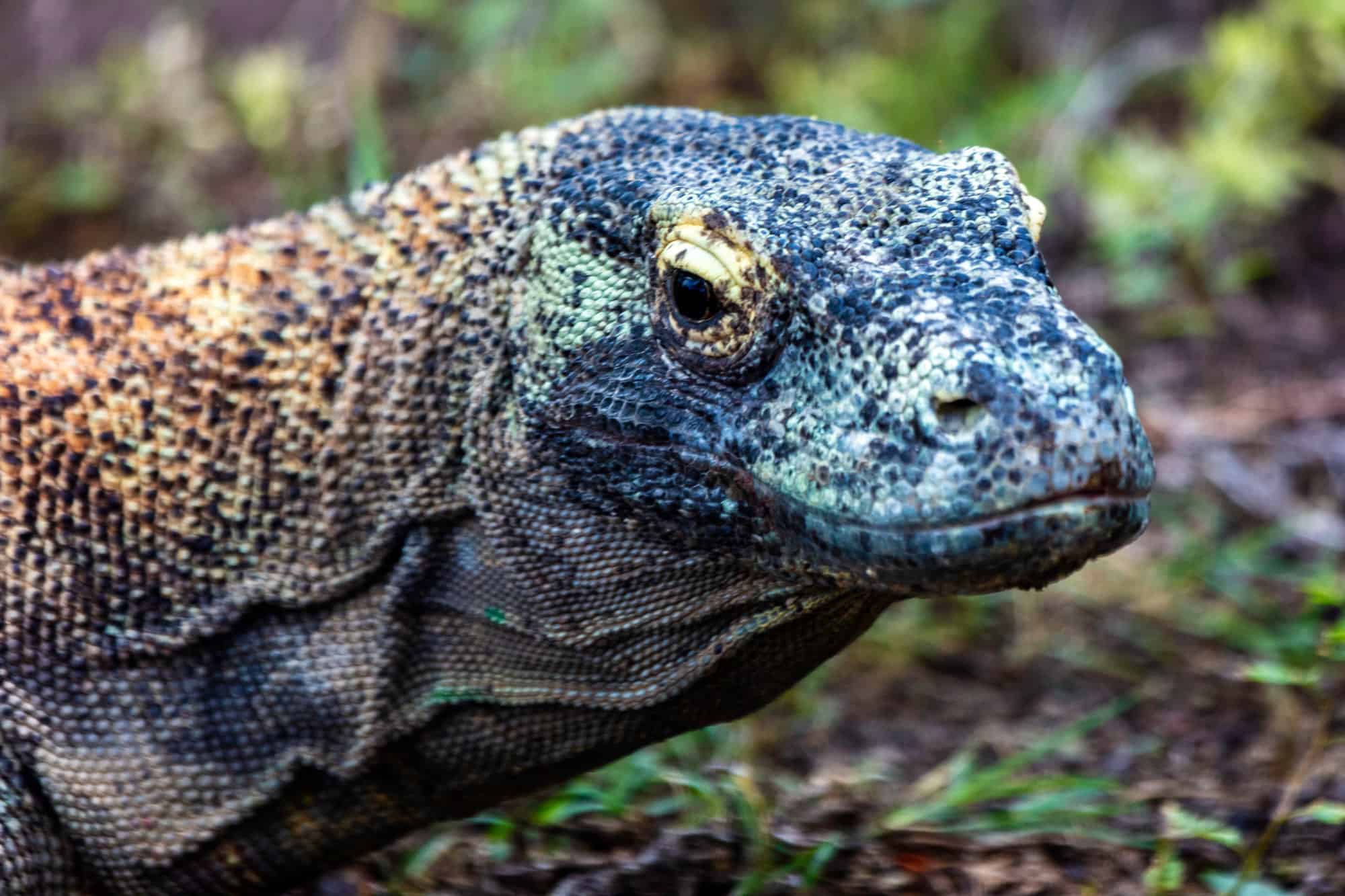
Komodo Dragons have excellent eyesight and powerful jaws
©iStock.com/desertsolitaire
Komodo Dragons are enormous reptiles that can grow up to three meters long and weigh 150kg. They are incredibly aggressive with long, thick bodies, short, muscular legs, and a powerful tails. Their tail is used for both fightings and for propping the animal up when it is standing on its hind legs. The Komodo Dragon is an animal with long, sharp, curved claws that are often used for digging. Greyish brown skin is covered in small scales and folds around the neck. Komodo Dragons have relatively small heads compared to their large body size and wide, powerful jaws concealing a mouth filled with deadly bacteria and sharp teeth. Although Komodo dragons have good eyesight, they mainly rely on their forked tongue to smell their environments. By flicking its tongue out of its mouth, the lizard is able to “taste” scent particles in the air and locate live or dead prey up to 8km away.
The largest Komodo Dragon ever recorded weighed 365 pounds!
Distribution and Habitat
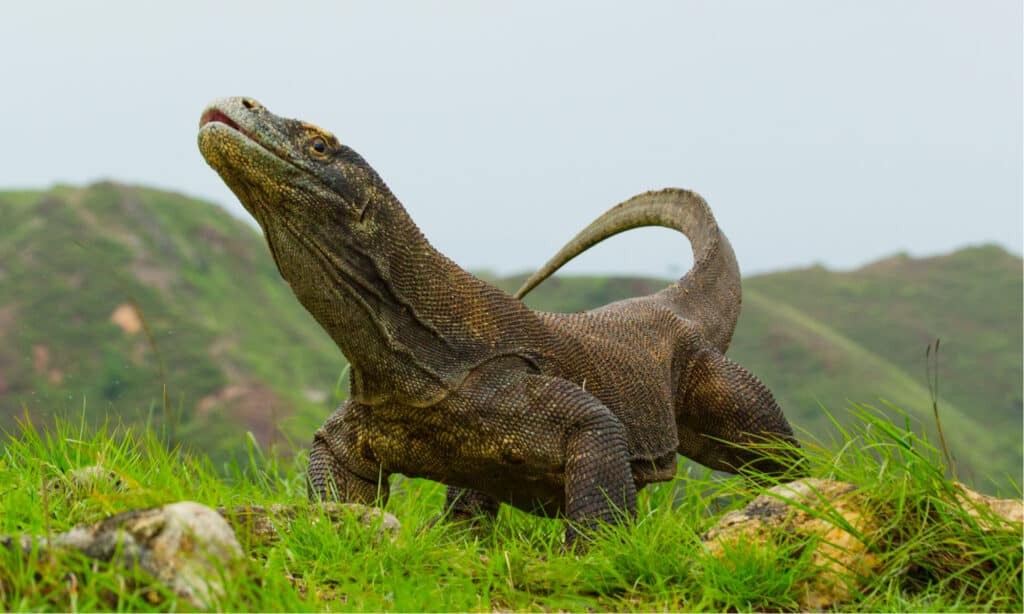
Komodo dragons can only be found on five Indonesian islands
©GUDKOV ANDREY/Shutterstock.com
Although the Komodo Dragon was once been widespread across many Indonesian islands, they are confined to just five today, all within Komodo National Park. The islands of Komodo, Rintja, Gillimontang, Padar and the western tip of Flores are the last remaining homes for these enormous animals. Habitats include open woodlands along with dry savannah and scrubby hillsides, occasionally dried-up river beds. Komodo Dragons are thought to have evolved to be so big due to the presence of a number of large mammalian species that are now extinct and the lack of other large predators.
Behavior and Lifestyle

Komodo Dragons are ambush predators and prefer to lie in wait for their prey
Komodo dragons are solitary and powerful predators, roaming territories dependent on the individual’s size, covering a distance of around 2km every day. They are also known to be excellent swimmers, traveling from one island to another over a relatively long distance. Although they are solitary animals, a number of Komodo Dragons will often gather around a single kill. In order to catch large animals, these lizards sit for hours, hidden in the vegetation, camouflaged by grey-brown skin. They then ambush the victim with incredible speed and force.
Reproduction and Life Cycles
Besides feeding on a large carcass, Komodo Dragons reside in groups during the breeding season, around September, when nearby males fight standing on their hind legs, propped up by their tails, vying for breeding rights. After mating, females lay up to 25 leathery eggs in a hole made of soft sand. The young hatch after an incubation period between 8 and 9 months and have distinguishing cream bands (which they lose as they get older). Young Komodo dragons are completely independent of the time they leave their shell. However, until they grow to a larger size, this young venture up into the trees, spending most of their time there until they are large enough to fend for themselves on the ground. These reptiles live for an average of 30 years in the wild.
Diet and Prey
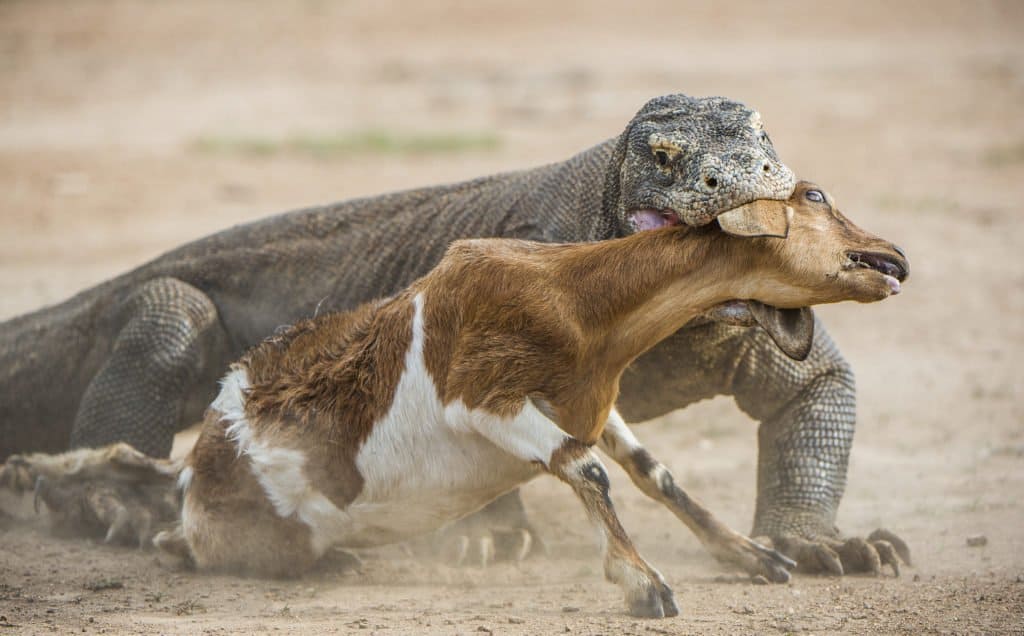
Komodo dragons hunt large herbivores and swallow chunks of their food rather than chew it
©Sergey Uryadnikov/Shutterstock.com
The Komodo Dragon is a carnivorous predator that relies on large animals, such as pigs, goats, deer, and even horses and water buffalo, as prey. Komodo dragons have the ability to attack prey much larger than them. Even if unsuccessful upon ambush, they will follow the injured prey for miles, waiting until it dies from sepsis caused by deadly bacteria in the reptile’s mouth. Young will prey on smaller animals mainly in the trees such as snakes, lizards, or birds. The teeth of this animal are sharp and serrated, good for the kill and tearing meat, but useless for chewing. Instead, Komodo dragons tear bits off the carcass, and throw it back into their mouths, swallowing it whole aided by their flexible neck muscles.
Predators and Threats
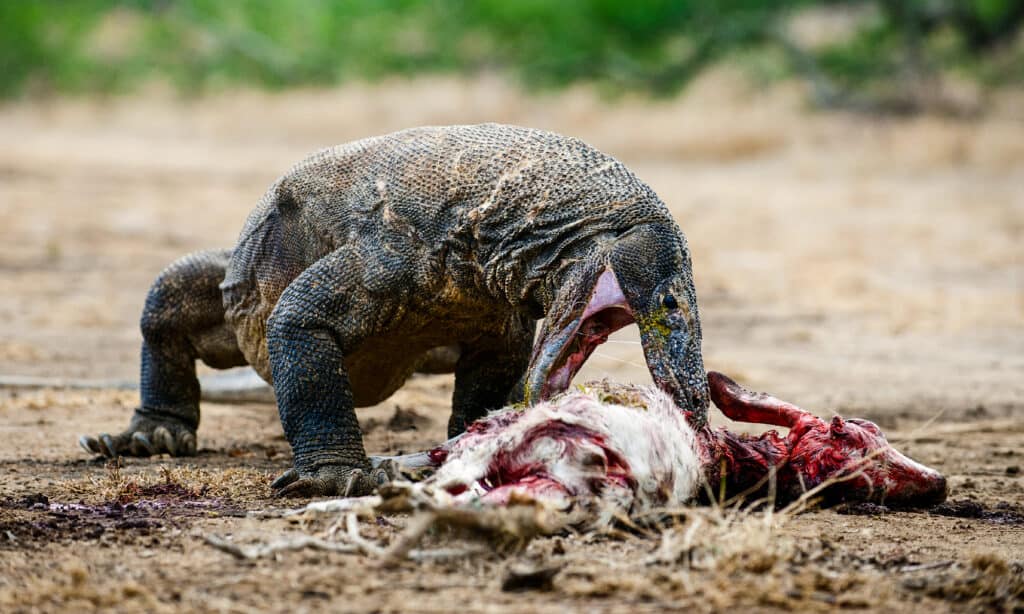
Komodo dragons are apex predators
©Sergey Uryadnikov/Shutterstock.com
Due to the fact that the Komodo Dragon is the most dominant predator in its environment, mature adults have no natural predators in their native habitats. Upon the first arrival of people on the islands, the Komodo dragon’s lifestyle changed dramatically. Humans hunt these lizards and encroach into their native habitats to establish settlements and clear forests for timber and agriculture. Volcanic activity also threatens these animals, as the islands are geologically active. Events such as this lead to declines in prey species, in turn affecting the local Komodo Dragon populations.
Komodo Dragons were Unknown Until Recently
Although Komodo Dragons have thrived in this part of the Indonesian archipelago for millions of years, they were unknown to the world until around a century ago. Initial reports came from a pilot stranded on Komodo Island after his plane crashed into the ocean. A species of Pygmy Elephant, thought to have now been extinct for thousands of years now, may have been a main source of food for Komodo dragons at one point. The main prey sources of Komodo dragons today were introduced by human settlers.
Komodo Dragons are Venomous
The Komodo Dragon has fifty different types of toxic bacteria in their saliva that thrive on traces of flesh, causing bite wounds to quickly become infected. However, recent studies indicate that the real reason for such a high success rate in killing prey could be down to the fact that a venom gland exists in this reptile’s mouth.
Researchers in Australia had the rare opportunity to examine two Komodo dragons that were put down in zoos due to terminal illnesses. The team found that the animal does possess a venom gland with venom capable of rapidly decreasing blood pressure and blood loss – sending the victim into shock and making it too weak to fight. Some compounds in the venom that reduce blood pressure were as potent as the world’s most venomous snake, the inland Taipan of Western Australia.
Komodo dragons also possess a venom delivery duct system that is more complex than the ones employed by snakes. While snakes have a single venom duct behind their fangs – Komodos have multiple ducts between their teeth. This means that instead of simply injecting venom with a bite – Komodo dragons bite and pull their victims to ooze the venom into wounds during a long, frenzied attack. This finding makes the whole bacteria theory almost laughable compared to this nightmarish means of killing. Read Are Komodo Dragons Poisonous or Dangerous? for more information.
Relationship with Humans
Since their discovery on the islands around 100 years ago, Komodo Dragons fascinate and honestly terrify people as we deduce more about them. Habitat loss on the islands not only means that Komodo Dragons face being pushed into isolated regions, but they are also coming into closer contact with human activity, leading to negative wildlife-livestock interactions. Despite their seemingly slow and docile nature, Komodo Dragons run at speeds of up to 11mph in short bursts and are actually one of the world’s known “man-eaters.” People have not only been ambushed but also bitten and then tracked by Komodo Dragons.
Conservation Status and Life Today
Today, the Komodo Dragon is listed by the IUCN as a species that is “vulnerable in its natural environment” and potentially faces extinction in the near future due to loss of habitat mainly from human activity, such as agricultural expansion. Although once widespread on numerous Indonesian islands, they are now confined to just a few with between 3,000 and 5,000 individuals thought to be left roaming the rich, volcanic forests. However, increasing interest in these creatures from tourists gives locals more reason to protect them and their critical habitats.
Similar Animals
- Iguana: Large and colorful, they’re considered an invasive species in some regions and a favorite among pet enthusiasts in others. Find out about this reptile which is capable of growing up to 7 feet.
- Monitor Lizard: Highly intelligent with a voracious appetite, they’re cousins to the Komodo dragon. Read about these lizards which have a metabolism that is similar to a mammal’s.
- Skink Lizard: Some are aquatic, and others are arboreal. And they’re found all over the planet. Here’s all you need to know about these reptiles capable of laying eggs and birthing live young at the same time.
Komodo Dragon FAQs (Frequently Asked Questions)
Who would win in a fight, a Komodo Dragon or an Anaconda?
While Komodo dragons are the largest lizards in the world, if they were to battle an anaconda, it’s likely the anaconda would win. While these two large reptiles don’t live together in nature, anacondas do live near large caimans they’ve been observed hunting.
Would a Komodo Dragon or Honey Badger win in a fight?
If a Komodo dragon fought a honey badger, it’s likely the Komodo dragon would win. While both are extremely effective predators, the size of a Komodo dragon would be too much for the honey badger to overcome. The two live in very different geographies, so this battle has never happened in nature.
What's the difference between Komodo dragons and monitor lizards?
Komodo dragons are the largest species of monitor lizard. While most other monitor lizards reach between 3 and 7 feet, Komodo dragons can reach beyond 10 feet in length.
Are Komodo Dragons herbivores, carnivores, or omnivores?
Komodo Dragons are Carnivores, meaning they eat other animals.
What Kingdom do Komodo Dragons belong to?
Komodo Dragons belong to the Kingdom Animalia.
What phylum do Komodo Dragons belong to?
Komodo Dragons belong to the phylum Chordata.
What class do Komodo Dragons belong to?
Komodo Dragons belong to the class Reptilia.
What family do Komodo Dragons belong to?
Komodo Dragons belong to the family Varanidae.
What order do Komodo Dragons belong to?
Komodo Dragons belong to the order Squamata.
What genus do Komodo Dragons belong to?
Komodo Dragons belong to the genus Varanus.
What type of covering do Komodo Dragons have?
Komodo Dragons are covered in Scales.
In what type of habitat do Komodo Dragons live?
Komodo Dragons live in open woodlands and hillsides.
What is the average litter size for a Komodo Dragon?
The average litter size for a Komodo Dragon is 20.
What is an interesting fact about Komodo Dragons?
Komodo Dragons are only found on five Indonesian islands.
What is the scientific name for the Komodo Dragon?
The scientific name for the Komodo Dragon is Varanus komodoensis.
What is the lifespan of a Komodo Dragon?
Komodo Dragons can live for 25 to 40 years.
What is a baby Komodo Dragon called?
A baby Komodo Dragon is called a pup.
How many species of Komodo Dragon are there?
There is 1 species of Komodo Dragon.
What is the biggest threat to the Komodo Dragon?
The biggest threats to the Komodo Dragon are hunting and habitat loss.
What is another name for the Komodo Dragon?
The Komodo Dragon is also called the Komodo monitor.
How many Komodo Dragons are left in the world?
There are between 3,000 and 5,000 Komodo Dragons left in the world.
How fast is a Komodo Dragon?
A Komodo Dragon can travel at speeds of up to 11 miles per hour.
How do Komodo Dragons have babies?
Komodo Dragons lay eggs.
Who will win a fight between a Komodo dragon and a lion?
A lion would win a fight against a Komodo dragon. Lions are larger, heavier, and have something that the Komodo dragon lacks: the ability to kill their enemy with a single blow. Sure, the Komodo dragon has osteoderms that can prevent some damage from being done, but a lion can simply bite the less-guarded neck of the lizard and kill it very quickly.
Who will win a fight between a bear and a Komodo dragon?
A bear would beat a Komodo dragon in a fight, but it might get bloody. The problem that Komodo dragons face is that they are very short compared to a bear. For example, if a Komodo dragon approached a grizzly bear, the bear would stand on its legs to appear bigger and scare it away.
Who would win a fight between a Komodo dragon and a tiger?
A tiger would win a fight against a Komodo dragon. An ambush by the tiger would instantly end a fight against a Komodo dragon, and the tiger would just as easily win a battle without the element of surprise. In fact, if it was attacked from hiding by the Komodo dragon, which is not likely, then it would turn the tables on the smaller, weaker animal.
Who would a fight between a Komodo dragon and a T-rex?
The T-rex would beat a Komodo dragon in a fight using its massive size advantage and powerful bite. Although unlikely, the Komodo dragon might attempt an ambush attack if it absolutely had to fight the monstrous dinosaur.
Who would win a fight between a Komodo dragon and a gorilla?
A gorilla would beat a Komodo dragon in a fight. Many people believe that Komodo dragons are venomous. While that is true in a sense, they don’t have a venom that will paralyze and knock out their prey. In fact, many of their victims die from exsanguination and brutal soft tissue damage.
Who will win a fight between a Komodo dragon and a shark?
A shark would win a fight against a Komodo dragon, and it wouldn’t even be close.
Who will win in a fight between a Komodo dragon and a cassowary?
A Komodo dragon would win in a fight against a cassowary, despite it being the world’s deadliest bird. However, there is a good chance that a cassowary would escape before being defeated.
What's the difference between Komodo dragons and iguanas?
Iguanas differ from Komodo dragons significantly in size. Iguanas are often pets, while Komodo dragons are dangerous predators!
How to say Komodo Dragon in ...
Thank you for reading! Have some feedback for us? Contact the AZ Animals editorial team.
Sources
- David Burnie, Dorling Kindersley (2011) Animal, The Definitive Visual Guide To The World's Wildlife
- Tom Jackson, Lorenz Books (2007) The World Encyclopedia Of Animals
- David Burnie, Kingfisher (2011) The Kingfisher Animal Encyclopedia
- Richard Mackay, University of California Press (2009) The Atlas Of Endangered Species
- David Burnie, Dorling Kindersley (2008) Illustrated Encyclopedia Of Animals
- Dorling Kindersley (2006) Dorling Kindersley Encyclopedia Of Animals
- Komodo Dragon Information, Available here: http://animals.nationalgeographic.com/animals/reptiles/komodo-dragon/
- Komodo Dragon Facts, Available here: http://www.honoluluzoo.org/komodo_dragon.htm
- Komodo Dragon Conservation, Available here: http://www.iucnredlist.org/apps/redlist/details/22884/0

















